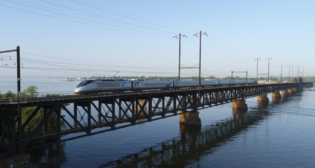
Ontario details GO Transit electrification plan
Written by John Thompson, Canadian Contributing EditorThe Minister of Transportation of the Province of Ontario recently outlined plans for the electrification of certain GO Transit regional rail lines, including an implementation schedule.
Electrification is planned for most corridors by 2022-2024, commencing with portions of the Kitchener and Stouffville lines in 2022-2023, followed by the Barrie and Lakeshore (GO’s original route, from 1967) lines in 2023-2024. The announcement did not mention whether the Kitchener electrification would include the Union Pearson Express (to Pearson International Airport in suburban Mississauga), which is due to open June 6, 2015, utilizing diesel multiple-unit equipment.
The electrification’s scope will be as follows:
• Kitchener Line: Bramalea Station to Toronto Union Station.
• Stouffville Line: Unionville Station to Union Station.
• Lakeshore East Line: Full corridor from Union Station to Oshawa .
• Lakeshore West Line: Burlington Station to Union Station.
• Barrie Line: Full corridor.
The Milton and Richmond Hill lines are absent from the present electrification project. The Milton Line is excluded due to the fact that the trackage is owned by the Canadian Pacific Railway, and implementation costs would thus be significantly higher than for the other routes.
In the case of the Richmond Hill Line, significant flood protection work is needed in the lower Don Valley, where the right-of-way closely parallels the Don River and is subject to periodic flooding. In addition, a grade separation is needed at Doncaster Junction, in North Toronto, where the Bala Subdivision used by GO trains crosses CN’s busy York Subdivision.
It is evident that Metrolinx, the overall provincial transit agency, has decided to focus its funding for the next decade in areas that electrification and corresponding improved service are relatively easy to implement, on trackage generally owned by Metrolinx.
On the Lakeshore East Line, there has been discussion for some time about extending rail service eastward approximately 10 miles from Oshawa. One scenario has a new GO alignment turning northeastward just beyond the Oshawa station, crossing Highway 401, and following CPR’s Toronto-Montreal line to Bowmanville. However, a firm implementation schedule for this undertaking, which would be extremely costly, has not been announced.
The electrification limits correspond, generally, to the territory where all-day 15-minute service will be provided. This will be the heart of the new Regional Express Rail network, with less frequent, diesel-hauled service running through to the less patronized non-electrified sections. The announcement did not specify whether the electric (or possibly dual-power) rolling stock would be locomotive-hauled or MU, or a combination of both. All GO trains have been locomotive-hauled for many years, following a somewhat unsatisfactory experience with DMUs in the system’s early years. It is virtually certain that the electrification will take the form of overhead catenary. With this in mind, overhead bridges built on the Lakeshore East and West lines have for many years been constructed with sufficient clearance for wires.
Prior to electrification, GO plans to significantly improve service on the affected lines to essentially the all-day level. The agency will thus become, in effect, a regional rapid transit service, transforming from its original traditional role as primarily a rush hour commuter service, with off peak service on the busiest line, the Lakeshore Line.
Between 2015 and 2020, the Kitchener Line is expected to accommodate the greatest increase in the number of trains, although the majority will not run all the way through to Kitchener. The service buildup will be completed in 2017.
The Barrie Line is due to receive weekend service in 2016-2017, with weekday off-peak trains following in 2017-2018. The Stouffville Line also obtains full weekday service in 2017-2018, while weekend service follows in 2018-2019.
Minor off-peak improvements are scheduled for the Lakeshore corridor in 2018-2019. A new station in downtown Hamilton, on CN’s Grimsby Subdivision, was scheduled for mid-2015 opening, to serve several trains that would be extended beyond the Aldershot (West Burlington) station. GO’s summertime Niagara Falls trains are also planned to use this facility.
The four weekday peak-period trains presently serving the Hunter Street GO Centre will continue to use this facility, which is more conveniently located in the heart of central Hamilton. However, further service expansion to this station would be constricted by a short single-track tunnel.
SNC-Lavalin and Hatch Mott MacDonald are among more than two dozen companies that have expressed interest in becoming Metrolinx’s general engineering contractor for the electrification program.
The overall increases to the GO Transit rail system will result in 32 additional trains by 2019-2020.



